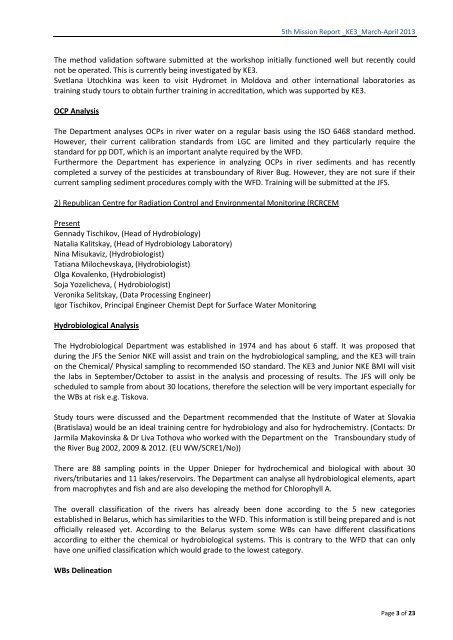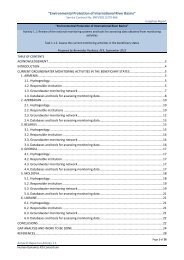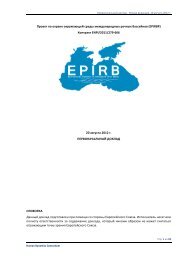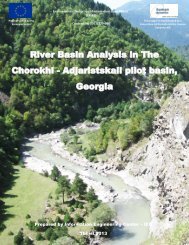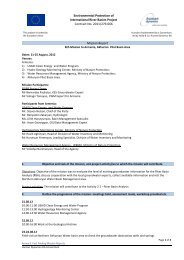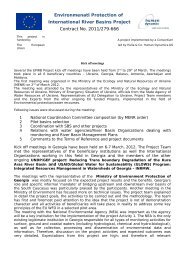Nokia Standard Document Template - Environmental Protection of ...
Nokia Standard Document Template - Environmental Protection of ...
Nokia Standard Document Template - Environmental Protection of ...
- No tags were found...
You also want an ePaper? Increase the reach of your titles
YUMPU automatically turns print PDFs into web optimized ePapers that Google loves.
5th Mission Report _KE3_March-April 2013The method validation s<strong>of</strong>tware submitted at the workshop initially functioned well but recently couldnot be operated. This is currently being investigated by KE3.Svetlana Utochkina was keen to visit Hydromet in Moldova and other international laboratories astraining study tours to obtain further training in accreditation, which was supported by KE3.OCP AnalysisThe Department analyses OCPs in river water on a regular basis using the ISO 6468 standard method.However, their current calibration standards from LGC are limited and they particularly require thestandard for pp DDT, which is an important analyte required by the WFD.Furthermore the Department has experience in analyzing OCPs in river sediments and has recentlycompleted a survey <strong>of</strong> the pesticides at transboundary <strong>of</strong> River Bug. However, they are not sure if theircurrent sampling sediment procedures comply with the WFD. Training will be submitted at the JFS.2) Republican Centre for Radiation Control and <strong>Environmental</strong> Monitoring (RCRCEMPresentGennady Tischikov, (Head <strong>of</strong> Hydrobiology)Natalia Kalitskay, (Head <strong>of</strong> Hydrobiology Laboratory)Nina Misukaviz, (Hydrobiologist)Tatiana Milochevskaya, (Hydrobiologist)Olga Kovalenko, (Hydrobiologist)Soja Yozelicheva, ( Hydrobiologist)Veronika Selitskay, (Data Processing Engineer)Igor Tischikov, Principal Engineer Chemist Dept for Surface Water MonitoringHydrobiological AnalysisThe Hydrobiological Department was established in 1974 and has about 6 staff. It was proposed thatduring the JFS the Senior NKE will assist and train on the hydrobiological sampling, and the KE3 will trainon the Chemical/ Physical sampling to recommended ISO standard. The KE3 and Junior NKE BMI will visitthe labs in September/October to assist in the analysis and processing <strong>of</strong> results. The JFS will only bescheduled to sample from about 30 locations, therefore the selection will be very important especially forthe WBs at risk e.g. Tiskova.Study tours were discussed and the Department recommended that the Institute <strong>of</strong> Water at Slovakia(Bratislava) would be an ideal training centre for hydrobiology and also for hydrochemistry. (Contacts: DrJarmila Makovinska & Dr Liva Tothova who worked with the Department on the Transboundary study <strong>of</strong>the River Bug 2002, 2009 & 2012. (EU WW/SCRE1/No))There are 88 sampling points in the Upper Dnieper for hydrochemical and biological with about 30rivers/tributaries and 11 lakes/reservoirs. The Department can analyse all hydrobiological elements, apartfrom macrophytes and fish and are also developing the method for Chlorophyll A.The overall classification <strong>of</strong> the rivers has already been done according to the 5 new categoriesestablished in Belarus, which has similarities to the WFD. This information is still being prepared and is not<strong>of</strong>ficially released yet. According to the Belarus system some WBs can have different classificationsaccording to either the chemical or hydrobiological systems. This is contrary to the WFD that can onlyhave one unified classification which would grade to the lowest category.WBs DelineationPage 3 <strong>of</strong> 23


